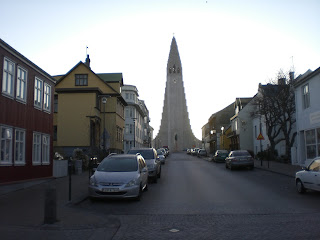Favourite Places: Thingholt

By ‘Thingholt’, I mean the bloody great hill in the middle of Reykjavík with a church on top. I assume that in Viking times, they held one of those ‘thingi’ things here, meaning an assembly. It’s bordered by the Tjörnin pond on the west, Laugavegur to the north, the National Hospital to the east and the City airport to the south. It’s a residential area bang in the middle of town, full of small houses with brightly painted corrugated iron roofs — predominantly red, but also green and blue. The walls are either concrete or corrugated iron, and many are brightly painted too. Most of the houses with corrugated metal walls were built between 1880 and 1925. The rain in Reykjavík frequently falls horizontally, so wooden walls tended to rot. Wood was also expensive, since it all had to be imported, and it burns: much of Reykjavík burned down in 1915. Corrugated iron was all the rage until the Icelanders discovered concrete in the 1920s. The dwellings are small, with little gables and tiny g...
